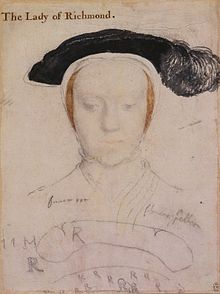Henry FitzRoy, Duke of Richmond and Somerset
The policy of discretion worked, as the baby boy's arrival caused no great stir, and diplomatic dispatches record nothing of Henry VIII's illegitimate son.[12] In addition, the correspondence of the child's first known tutor makes it clear that FitzRoy also received some rudimentary education prior to his elevation to the peerage in 1525.John Palsgrave grumbled loudly that Henry had been taught to recite his prayers in a "barbarous" Latin accent and dismissed the man who had instructed him as "no clerk".Although he was more well known from 1525 and onwards, there is some evidence that he was already in receipt of royal favour even before his ennoblement; this comes from a surviving list of "Wardrobe stuff appointed for my lord Henry".Henry had no surviving younger brother nor any close male relations from his father's family who could be called up to share the burden of government in the King's name.[15] The King's chief minister at the time was Cardinal Thomas Wolsey, and since Henry FitzRoy's birth, he had taken an interest in his monarch's only son.[16] Since his birth FitzRoy had remained in the background, although the boy had been brought up in remarkable style and comfort, almost as if he were a prince of the blood and not an acknowledged royal bastard.That morning of the 18th, the six-year-old Lord Henry FitzRoy travelled by barge from Wolsey's mansion of Durham Place, near Charing Cross, down the River Thames.[citation needed] As if to compound this sense of royal dignity and endow the child with as much respectability as possible, Henry VIII had granted his son the unprecedented honour of a double dukedom.The earldom of Nottingham had been held by Richmond's great uncle Prince Richard of Shrewsbury, Duke of York, the second son of Edward IV.In a private letter, the Venetian ambassador wrote: "It seems that the Queen resents the earldom and dukedom conferred on the King’s natural son and remains dissatisfied.At the instigation it is said of her three Spanish ladies her chief counsellors, so that the King has dismissed them from court, a strong measure but the Queen was obliged to submit and have patience".Richmond's ceremony was by far the most spectacular but it was also a public relations display, since the last member of the Yorkist faction, Richard de la Pole, lost his life in February of that same year fighting for the French at the Battle of Pavia.In February 1527, Thomas Magnus told the young Duke that King James V of Scotland, FitzRoy's first cousin, had asked for hunting dogs.As part of the negotiations, Richmond joined the French court and lived with the Dauphin Francis and his younger brother, the future King Henry II of France, until August 1533, when he was recalled to England.Anxious to prevent the annulment and Henry's possible break with the Roman Catholic Church, the Pope was even prepared to grant a special dispensation for their marriage.[30] At the time of Richmond's death, an Act was going through Parliament which disinherited Henry's daughter Elizabeth as his heir and permitted the King to designate his successor, whether legitimate or not.[31] The Imperial ambassador Eustace Chapuys wrote to Emperor Charles V on 8 July 1536 that Henry VIII had made a statute allowing him to nominate a successor, but thought the Duke of Richmond would not succeed to the throne by it, as he was consumptive and now diagnosed incurable.According to the chronicler Charles Wriothesley, he became sickly some time before he died, although his biographer Beverley A. Murphy cites his documented public appearances and activities in April and May of that year, without exciting comment on his health.[35][36][37] FitzRoy's tomb has a mix of royal and religious iconography, with his personal coat of arms surrounded by the collar of the Order of the Garter and the Order's motto "Honi soit qui mal y pense", and the coats of arms of the Howard family (by his marriage to Mary Howard), and friezes showing scenes from the Biblical Old Testament (mainly from the Book of Genesis and part of the Book of Exodus).




Henry FitzRoy (disambiguation)His GraceLucas HorenboutLord High Admiral of EnglandHenry VIIIThe Duke of NorfolkThe Earl of SouthamptonLord Lieutenant of IrelandThe Earl of OssoryWilliam SkeffingtonBlackmoreSt. James's PalaceLondonThetford PriorySt Michael the Archangel, FramlinghamLady Mary HowardHenry VIII of EnglandElizabeth Blounthis mistressMary IElizabeth IEdward VIElizabethGeorgeRobert TailboysCatherine of Aragona stillborn daughterAugustinian prioryIngatestoneThomas WolseyWindsorHampton CourtWestminsterThomas Howard, 3rd Duke of NorfolkDukedom of NorfolkHouse of HowardThomas HowardHenry BrandonFitzRoyBridewell PalaceillegitimateEdwardMargaret Pole, Countess of SalisburyMargaret BryanJohn PalsgraveGilbert Tailboys, 1st Baron Tailboys of KymeHouse of Tudorhad other illegitimate childrenHenry VIIDurham Housethe Strandroyal bastardDurham PlaceCharing CrossRiver ThamesCharles Brandon, 1st Duke of SuffolkEarl of NottinghamHenry Percy, 5th Earl of NorthumberlandJohn de Vere, 14th Earl of OxfordWilliam FitzAlan, 18th Earl of ArundelSir Thomas MorepeerageHenry II, King of EnglandEarl of SalisburyEarl of NorthumberlandThomas Grey, 2nd Marquess of DorsetEarl of ArundelEarl of OxfordDuke of RichmondSomersetEdward III, King of EnglandEdward, Prince of WalesMargaret BeaufortEdmund Tudor, 1st Earl of RichmondRichard of Shrewsbury, Duke of YorkHenry Courtenay, 1st Marquess of ExeterCatherine of YorkElizabeth of YorkAnne of YorkEleanor BrandonRichard de la PoleBattle of PaviaCouncil of the NorthWarden of the Marches towards ScotlandGovernor of CarlisleThomas MagnusArchdeacon of the East RidingSheriff Hutton CastleSir Thomas TempestJames V of ScotlandLord-Lieutenant of IrelandCrown of Ireland Act 1542personal unionKing Henry VIII of EnglandFrancis I of FranceFrancisHenry II of FranceHans Holbein the Youngerbreak with the Roman Catholic ChurchHenry Howard, Earl of SurreyParliamentEustace ChapuysEmperor Charles VCharles WriothesleytuberculosisSt Michael the Archangel's Church, Framlinghamdissolution of the monasteriesChurch of St Michael the Archangel, FramlinghamBiblicalOld TestamentBook of GenesisBook of ExodusNoah's ArkAbrahamSodom and GomorrahLaw tablesGolden CalfBeaufortDorsetLancasterHertfordWorcesterLeicesterMiddlesexYarmouthEarl of Dorset